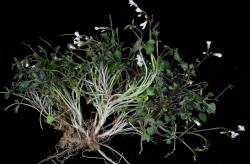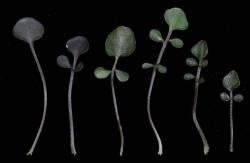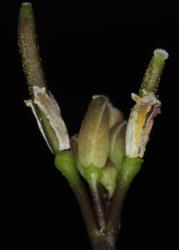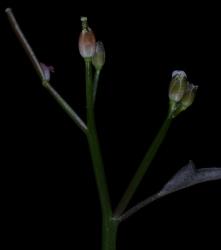Perennial herb, single rosette or with short lateral branches, stem and branches 0.8–1.2 mm diam., rhizomatous. Leaves up to 80 mm long, pinnatisect; lamina 10.0–38.0 × 8.0–17.0 mm, usually grey-green to brown-green, occasionally green, coriaceous, glabrous or sparsely hairy on abaxial and adaxial surfaces, margin and petiole. Terminal pinna 2.0–17.0(–25.0) × 2.0–20.0(–30.0) mm, usually simple, sometimes with 1–2 shallow lobes, orbicular, orbicular-rhomboid, to broadly elliptic, apex obtuse with an inconspicuous hydathode, base obtuse, truncate or weakly cordate and sometimes oblique. Lateral pinnae 2–4, 2.0–6.2 × 2.0–6.2, orbicular, orbicular-rhomboid, to broadly elliptic, petiolule 0.8–5.0 mm long; petiole up to 50 mm long; hairs septate and 0.5–0.7 mm long. Cauline leaves similar to rosette leaves but smaller and with fewer lateral pinnae. Inflorescence with 1–5 corymbs, each corymb 2–5-flowered and usually with a solitary flower lower down the peduncle, flowers occasionally solitary; peduncle up to 100(–180) mm long, 0.6–2.1 mm diam. at base, spreading to ascending, glabrous or occasionally sparsely hairy. Pedicels 9.0–16.0(–40.0) mm long, 0.2–0.4 mm diam., glabrous. Sepals 2.3–3.0 × 0.8–1.2 mm, elliptic-oblong to broadly elliptic, ± saccate, green or red-brown, glabrous or sparsely hairy distally, margin white and membranous, apex obtuse, base truncate. Petals absent or present, when present 4.5–6.5 × 1.9–2.5 mm, white, limb obovate to broadly elliptic; apex obtuse; base cuneate, tapering to a c. 1 mm long claw. Stamens 6; median filaments 4, 2.8–3.4 mm long; lateral filaments 2, 2.4–2.6 mm long; anthers 0.5–0.6 mm long, cream to pale yellow, when dehiscent held at a similar height to or slightly below the stigma. Ovary 3.0–4.0 mm long, 0.5–0.6 mm diam., ± terete, green, glabrous; ovules 28–36; style 0.3–0.4 mm long, ± terete; stigma 0.3–0.4 mm diam. Siliques 20.0–32.0(–40.0) × 1.0–1.2 mm, glabrous, style 0.6–0.9 mm long; valves green to red-brown at maturity; straw-coloured when dehiscent, replum 0.4–0.5 mm wide. Seeds 1.0–1.2 mm long, 0.8–0.9 mm wide, 0.3–0.5 mm thick, orbicular-oblong to broadly oblong, yellow-brown to henna; wing absent.
Cardamine glara is distinguished from C. corymbosa by its robust, rhizomatous growth habit, coriaceous, usually grey-green to brown-green leaves, the terminal leaf base usually obtuse or truncate, and larger flowers and siliques.
North Island: Gisborne, Volcanic Plateau, Southern North Island.
South Island: Western Nelson, Westland, Marlborough, Canterbury, Otago.
Cardamine glara most commonly occurs in mountainous areas on scree and alluvial river beds, but it also grows on seepages in montane and subalpine turf, and on crevices and ledges on cliffs and bluffs. It usually occurs on greywacke and limestone substrates.
Cardamine glara is assessed as having a conservation status of Not Threatened (de Lange et al. 2018).
Putative hybrids between C. glara and C. dimidia have been collected from the Yeo Stream, Marlborough (South Island). These plants (e.g., CHR 514766) have leaves intermediate in size, shape and number of lobes between the two putative parents.
Flowering September–March; Fruiting November–March.
Plants collected from limestone habitats (e.g., Castle Hill basin) appear to be slightly larger than those collected from greywacke habitats, but otherwise have the diagnostic features of C. glara. Previously referred to by the tagname Cardamine aff. corymbosa "scree race" (e.g., Pritchard 1957).












